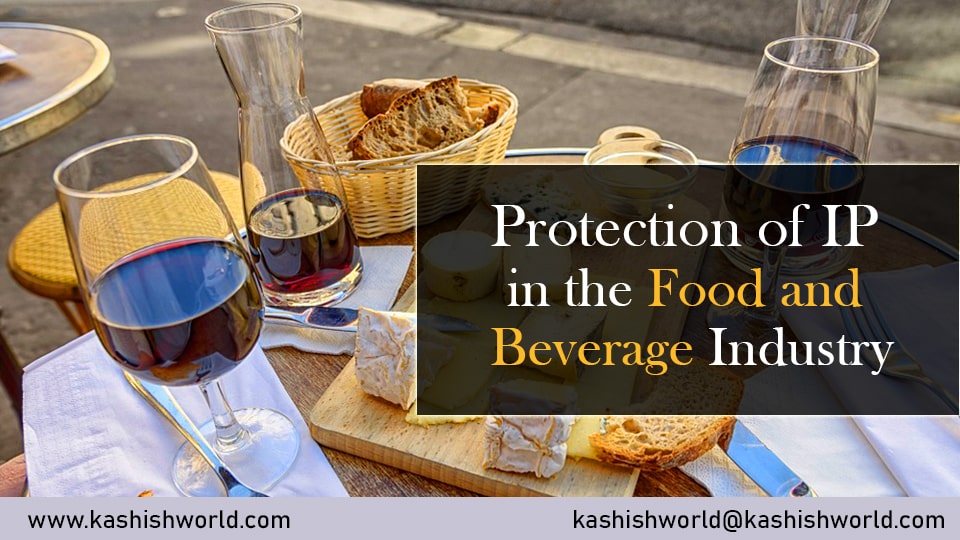
Protecting Intellectual Property (IP) in the food and beverage industry covers everything ranging from producing the ingredients, creation of recipes, labeling, and going all the way to marketing and branding of the finished or final products. Various forms of IP including, trademarks, patents, industrial designs, and trade secrets are relevant to the food and beverage sector and can prove to be extremely beneficial to the companies of this industry when they become successful.
A trademark could be any word, phrase, logo, symbol, or a combination of these which uniquely identifies and further distinguishes the source of origin of the goods and services of one party from another. There are various roles that a trademark plays in a company or an organization, and all of them are crucial in leading to the success of any business. In the food and beverage industry, a trademark is a valuable and significant asset. It helps the customers in choosing the food products according to their needs. For instance, the customers are aware of the fact that if they are purchasing a drink with the label ‘Coca-Cola,’ then they are buying a carbonated non-alcoholic beverage. Similarly, when the customers come across the label of ‘Berrywhite,’ they know that it is an organic drink made from berries and contains fewer additives. Moreover, the customers don’t need to read the ingredients every time they buy any food product.
Trademarks provide all the essential information about a product to the customers, including its commercial origin, value, and use. Once a trademark becomes well-known, the owner can not only prevent others from using the trademark but can also restrict them from using similar marks. For example, in 1972, Coca-Cola had sued Gemini Rising Inc., for selling posters with “Enjoy Cocaine” which were way too similar to the Coca-Cola trademark.
Industrial Designs protect the overall appearance of a product. In the food and beverage industry, industrial designs apply to the packaging of the product (either bottle or the entire packaging), and the shape of the product like that of a Toblerone chocolate bar. Protection of industrial designs not only prevents other companies from using the same packaging or bottle but also restricts them from using a similar container or packaging. If another person or company comes up with a product having minor changes making it appear similar to your product, such a competitor would be infringing your Intellectual Property Rights (IPR). Therefore, protecting industrial designs goes beyond direct copying. Additionally, any person or company planning to launch a new design of a bottle or a chocolate bar must ensure that the design is unique, novel, and possesses an individual character.
Patents are the exclusive forms of IP granted for the inventions and discoveries in all fields of scientific and human endeavors. It is very likely for a new food mixture or a recipe of a beverage to seek Patent Protection in the food and beverage sector. However, the food or drink must be new, non-obvious, and useful, and adequately explained in the Patent Application. A Recipe falls under patentable subject-matter and is protectable either by defining it as a new and useful process or as a composition of matter. For instance, a soft drink is a composition of matter, while the steps involved in making it can be patented as a new process. The monopoly of patent rights is the broadest among all other IP Rights. If another company slightly modifies a recipe by either adding or removing an ingredient, it is most likely to infringe your rights, and you can take legal action against the competitor offering such a product.
Another form of IP actively used in this industry is trade secrets. A trade secret is any process, formula, or practice, which is not generally or reasonably known to others. Usually used to protect the recipes of food items and beverages, trade secrets offer an economic advantage to the business owners in the food sector. The most common example of a beverage recipe protected by trade secrets is of Coca-Cola, invented in 1886 by Dr. John S. Pemberton. However, nowadays, it has become much harder to keep a trade secret as a good chemist is capable of disclosing the ingredients of any drink or food item by doing analysis and running a few tests. Therefore, companies in this sector should invest in higher IP Protection by filing a Patent Application for the same.
BOTTOM LINE
IP Rights play a crucial role in the food and beverage industry if the owners wisely make decisions in managing their IP Portfolio. Since the manufacturing and preparation of food items is getting cheaper day by day, going close to zero marginal costs, the consumers must be provided with unique and new products having individual labels and designs. Therefore, the owners must consider the needs of their customers and then invest in the intellectual creation of novel and attractive food products.

